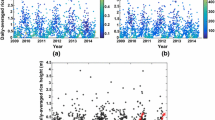Abstract
The projections of leaf areas onto a horizontal plane and onto a vertical plane are examined for their utility in characterizing canopies for sunlight penetration (direct beam only) models. These projections exactly specify the penetration if the projections on the principal plane of the normals to the top surfaces of the leaves are in the same quadrant as the Sun. Inferring the total leaf area from these projections (and therefore the penetration as a function of the total leaf area) is possible only with a large uncertainty (up to ±32%) because the projections are a specific measure of the total leaf area only if the leaf angle distribution is known. It is expected that this uncertainty could be reduced to more acceptable levels by making an approximate assessment of whether the zenith angle distribution is that of an extremophile canopy. An extremophile canopy would have the maximum leaf area possible for given set of projections. Simple leaf projection measurements would then become a practical substitute for detailed measurements of the leaf angle distribution. This is not true if for a fraction of the canopy, the leaf normal projections fall in the non-solar quadrant. In this case, accurate and detailed information about the leaf orientation is required for assessing the penetration; the horizontal and vertical projections are inadequate for this purpose.
Similar content being viewed by others
References
Anderssen, R. S., Jackett, D. R., and Jupp, D. L. B.: 1984, ‘Linear Functional of the Foliage Angle Distribution as Tools to Study the Structure of Plant Canopies’, Aust. J. Bot. 32, 147–156.
Federer, C. A.: 1968, ‘Spatial Variation of Net Radiation, Albedo, and Surface Temperature of Forests’, J. Appl. Meteorol. 7, 789–795.
Federer, C. A.: 1971, ‘Solar Radiation Absorption by Leafless Hardwood Forests’, Agricultural Meteorol. 9, 3–20.
Goudriaan, J.: 1973, ‘A Calculation Model and Descriptive Formulas for the Extinction and Reflection of Radiation in Leaf Canopies’, Proceedings, The Sun in Service of Mankind, International UNESCO Conference, Paris.
Idso, S. and de Wit, C.: 1971, ‘Light Relations in Plant Canopies’, Appl. Optics 9, 177–184.
Kimes, D. S.: 1984, ‘Modeling the Directional Reflectance from Complete Homogeneous Vegetation Canopies with Various Leaf-Orientation Distributions’, J. Opt. Soc. Am. 1, 725–737.
Kimes, D. S. and Kirchner, J. A.: 1983, ‘Diurnal Variations of Vegetation Canopy Structure’, Int. J. Remote Sensing 4, 257–271.
Lang, A. R. G., Xiang, Y., and Norman, J. M.: 1985, ‘Crop Structure and the Penetration of Direct Sunlight’, Agric. Forest Meteorol. 35, 83–101.
Lemeur, R.: 1973, ‘A Method for Simulating the Direct Solar Radiation Regime in Sunflower, Jerusalem Artichoke, Corn and Soybean Canopies Using Actual Stand Structure Data’, Agric. Meteorol. 12, 229–247.
Monteith, J. L.: 1965, ‘Light Distribution and Photosynthesis in Field Crops’, Ann. Bot. 29, 17–37.
Monteith, J. L.: 1973, Principles of Environmental Physics, Edward Arnold, London, 241 p.
Norman, J. M.: 1975, in D. A. de Vries and N. H. Afgan (eds.), ‘Radiative Transfer in Vegetation’, Energy Exchange in the Biosphere, Scripta Books Co., Washington, DC.
Otterman, J.: 1983, ‘Absorption of Insolation by Land Surfaces with Sparse Vertical Protrusions’, Tellus 35B, 309–318.
Otterman, J.: 1984, ‘Albedo of a Forest Modeled as a Plane with Dense Protrusions’, J. Climate Appl. Meteorol. 23, 297–307.
Otterman, J.: 1985, ‘Bidirectional and Hemispheric Reflectivities of a Bright Soil-Plane and a Sparse Dark Canopy’, Int. J. Remote Sensing 6, 896–902.
Otterman, J. and Tucker, C. J.: 1985, ‘Satellite Measurements of Surface Albedo and Temperatures in Semi-Desert’, J. Climate Appl. Meteorol. 24, 228–235.
Sievers, U. and Zdunkowski, W.: 1985, ‘A Numerical Simulation Scheme for the Albedo of City Street Canyons’, Boundary-Layer Meteorol. 33, 245–257.
Smith, J. A., Oliver, R. E., and Berry, J. K.: 1977, ‘A Comparison of Two Photographic Techniques for Estimating Foliage Angle Distribution’, Aust. J. Bot. 25, 545–553.
Wilson, W. J.: 1960, ‘Inclined Point Quadrats’, New Phytol. 59, 1–8.
Author information
Authors and Affiliations
Rights and permissions
About this article
Cite this article
Otterman, J., Brakke, T. Penetration of sunlight into a canopy: Explicit models based on vertical and horizontal leaf projections. Boundary-Layer Meteorol 36, 335–349 (1986). https://doi.org/10.1007/BF00118336
Received:
Issue Date:
DOI: https://doi.org/10.1007/BF00118336




